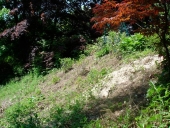





 2
2




 3
3




John Daley Bendigo, Australia The Enemy of progress is the hope of a perfect plan
Benefits of rainfall collection https://permies.com/t/88043/benefits-rainfall-collection
GOOD DEBT/ BAD DEBT https://permies.com/t/179218/mortgages-good-debt-bad-debt
















rob macintosh wrote:
You need to slow the water rushing through this gully. Most of the time this is a problem that starts at the niebour 6 places up and gets worse till it gets to you.
You can throw things up against the banks or make a series of dams to slow the water and try to get it sinking in and stop erosion. You will be suprised how much soil and organic matter piles up if you slow the water.
Ofcourse this all depends on how much water we are talking about.




Sometimes the answer is nothing





wayne fajkus wrote:Is this a ravine where all the water concentrates to a relatively small width. Or is this a very wide drop off where water sheets over a very large range?
 1
1




Sometimes the answer is nothing





wayne fajkus wrote:Book. Water harvesting for drylands, vol 1.
Thank you! Found and ordered on Amazon!




John Daley Bendigo, Australia The Enemy of progress is the hope of a perfect plan
Benefits of rainfall collection https://permies.com/t/88043/benefits-rainfall-collection
GOOD DEBT/ BAD DEBT https://permies.com/t/179218/mortgages-good-debt-bad-debt




John Daley Bendigo, Australia The Enemy of progress is the hope of a perfect plan
Benefits of rainfall collection https://permies.com/t/88043/benefits-rainfall-collection
GOOD DEBT/ BAD DEBT https://permies.com/t/179218/mortgages-good-debt-bad-debt




Moderator, Treatment Free Beekeepers group on Facebook.
https://www.facebook.com/groups/treatmentfreebeekeepers/









Invasive plants are Earth's way of insisting we notice her medicines. Stephen Herrod Buhner
Everyone learns what works by learning what doesn't work. Stephen Herrod Buhner




Hi, John. That is a pano of the lot; the gully is in the treeline on the right of the picture. All of Oklahoma is "Red Dirt" country, due to the high iron oxide content.John C Daley wrote:What does the image with the red soil show?




A human being should be able to change a diaper, plan an invasion, butcher a hog, conn a ship, design a building, write a sonnet, balance accounts, build a wall, set a bone, comfort the dying, take orders, give orders, cooperate, act alone, solve equations, analyze a new problem, pitch manure, program a computer, cook a tasty meal, fight efficiently, die gallantly. Specialization is for insects.
-Robert A. Heinlein




Michael Cox wrote:What is your location and climate like? What is the soil like - sandy? Clay?
It was hard to tell from your photos - how much water, and catchment area, is there upstream of you off the property? Or does the gully start on your own land?




From what I've seen, including just after a rain, it appears to start in three fairly wide drop offs, and where these converge, the water starts moving narrowly (about 2 feet wide) and quickly, scouring that south wall as it goes along. It finally hits a large fallen tree, which has caused a small deeper area, and then it follow that tree about 3 feet until it overflows into the actual drainage culvert.
Moderator, Treatment Free Beekeepers group on Facebook.
https://www.facebook.com/groups/treatmentfreebeekeepers/









John Daley Bendigo, Australia The Enemy of progress is the hope of a perfect plan
Benefits of rainfall collection https://permies.com/t/88043/benefits-rainfall-collection
GOOD DEBT/ BAD DEBT https://permies.com/t/179218/mortgages-good-debt-bad-debt




A human being should be able to change a diaper, plan an invasion, butcher a hog, conn a ship, design a building, write a sonnet, balance accounts, build a wall, set a bone, comfort the dying, take orders, give orders, cooperate, act alone, solve equations, analyze a new problem, pitch manure, program a computer, cook a tasty meal, fight efficiently, die gallantly. Specialization is for insects.
-Robert A. Heinlein

|
They gave me pumpkin ice cream. It was not pumpkin pie ice cream. Wiping my tongue on this tiny ad:
The new purple deck of permaculture playing cards
https://www.kickstarter.com/projects/paulwheaton/garden-cards
|






